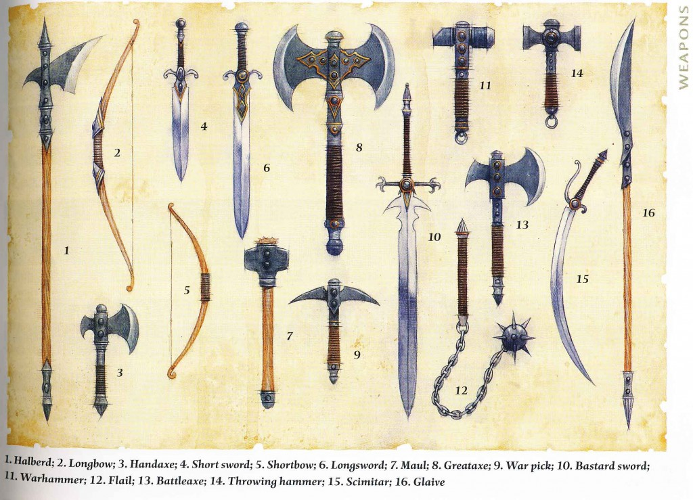D&D&R Chapter 2: Weapon-Probabilities Included
Hello everyone,
A few months ago now(geez…) I started a new series in the blog where I decided to merge Dungeons and Dragons with my data science obsession. I am now ready to go into the next part of the series, Weapon Stats!! Like the first chapter in this series, I wanted this to be more exploratory than explanatory. With all that rambling out the way, I think it’s time we get into it!
So in D&D weapon combat is based on two general easy steps. The first step is the Attack Roll, where a player makes an attack using the D20 in order to determine if their attacks hit or not. If they are successful, they then roll a Damage Roll which determines how much damage they deliver. Damage Rolls are affected by the type of weapons used as well personal character modifiers.
Like stated earlier in the series, dice rolls have their own notations. This goes as follows:
For those of you who aren’t rich in nerd nomenclature, in the phrase xdy:
- x = Number of die
- d = Dice
- y = The number of sides on that die So the phrase 2d6 would mean two- six sided die
There are a bunch of different weapon types but the standard weapons generally follow this scheme:
- 1d4 - Dagger
- 1d6 - Shortsword
- 1d8 - Longsword
- 1d10 - Longsword(2-handed)
- 1d12 - Great Axe
- 2d6 - Greatsword
I decided to attach a weapon name to each damage type as a means to refer back to the damage roll without calling it by its dice nomenclature.
Most weapons that can use a 1d10 have a property called “Versatile” what this means is that the weapon damage is only a 1d10 if a certain condition is met(Usually using 2-hands as opposed to 1 to wield the weapon) Also weapons like the Greataxe and the Greatsword are two handed weapons. Generally speaking, wielding a weapon with two hands will grant you more damage at the cost of using that second hand for something else(Spell-Casting, holding a shield, ect…)
Like before I am going to be using the “dice” package in r
library(dice)
How is damage distributed among the weapon die?
Using the dice package I was able to get the following distributions
This is the D4 weapons
Dagger <-getSumProbs(ndicePerRoll = 1,
nsidesPerDie = 4,
perDieModifier = 0)
# This is the D6 Weapons
Shortsword<- getSumProbs(ndicePerRoll = 1,
nsidesPerDie = 6,
perDieModifier = 0)
# this is the D8 Weapons
Longsword <-getSumProbs(ndicePerRoll = 1,
nsidesPerDie = 8,
perDieModifier = 0)
# This is the D10 Weapons
Longsword2h <-getSumProbs(ndicePerRoll = 1,
nsidesPerDie = 10,
perDieModifier = 0)
# This is the D12 Weapon
Greataxe<-getSumProbs(ndicePerRoll = 1,
nsidesPerDie = 12,
perDieModifier = 0)
# This is the 2D6 weapon
Greatsword<- getSumProbs(ndicePerRoll = 2,
nsidesPerDie = 6,
perDieModifier = 0)
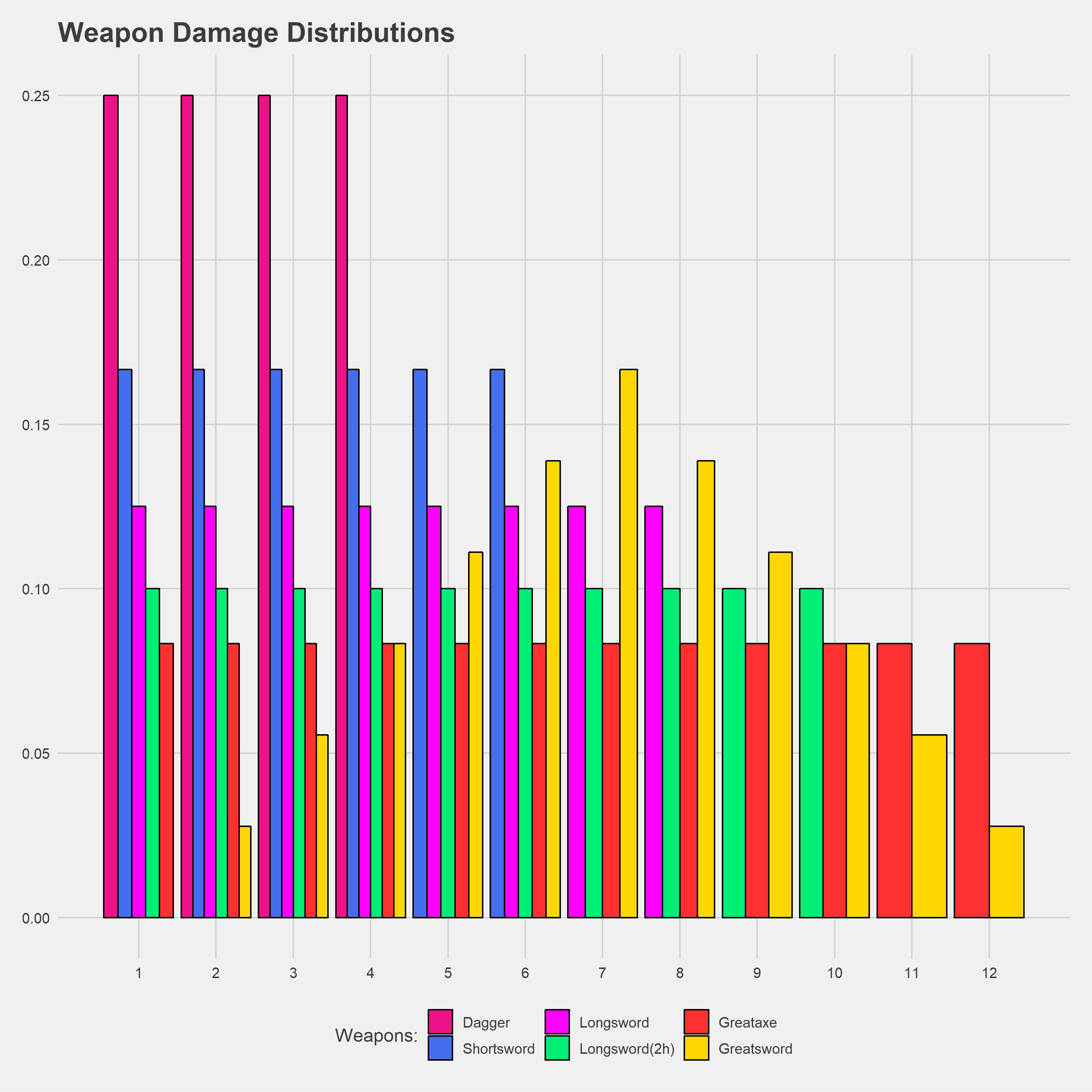 While the mathematical averages of the damage rolls mostly consist of x.5 since we can’t really deal half damage in D&D we can round up or down considering. A general rule of D&D is to round down
There are a bunch of different weapon types but the standard weapons generally follow this scheme:
While the mathematical averages of the damage rolls mostly consist of x.5 since we can’t really deal half damage in D&D we can round up or down considering. A general rule of D&D is to round down
There are a bunch of different weapon types but the standard weapons generally follow this scheme:
- Weapon Average Damage
- Dagger - 2.5(2)
- Shortsword - 3.5(3)
- Longsword - 4.5(4)
- Longsword(2-handed) - 5.5(5)
- Great Axe - 6.5(6)
- Greatsword - 7
Here is a distribution of the probability of a damage dice reaching a particular roll.
You can see that the D4 has the best chances of rolling any particular number but the numbers themselves are not very high. All the other damage die have equal chances to roll a particular number but the real kicker is the Greatsword(2d6)
The Great Debate(pun intended)
Players often compare the D12 and the 2d6 together(as they both have a maximum of 12 damage). Players will ask which is better, but I think players only look at the facts on a surface level. In truth, both weapons have their tradeoff and I think it’s up to the player to value which is more important to them given the information.
Let’s look at a quick subset of the probability distribution.
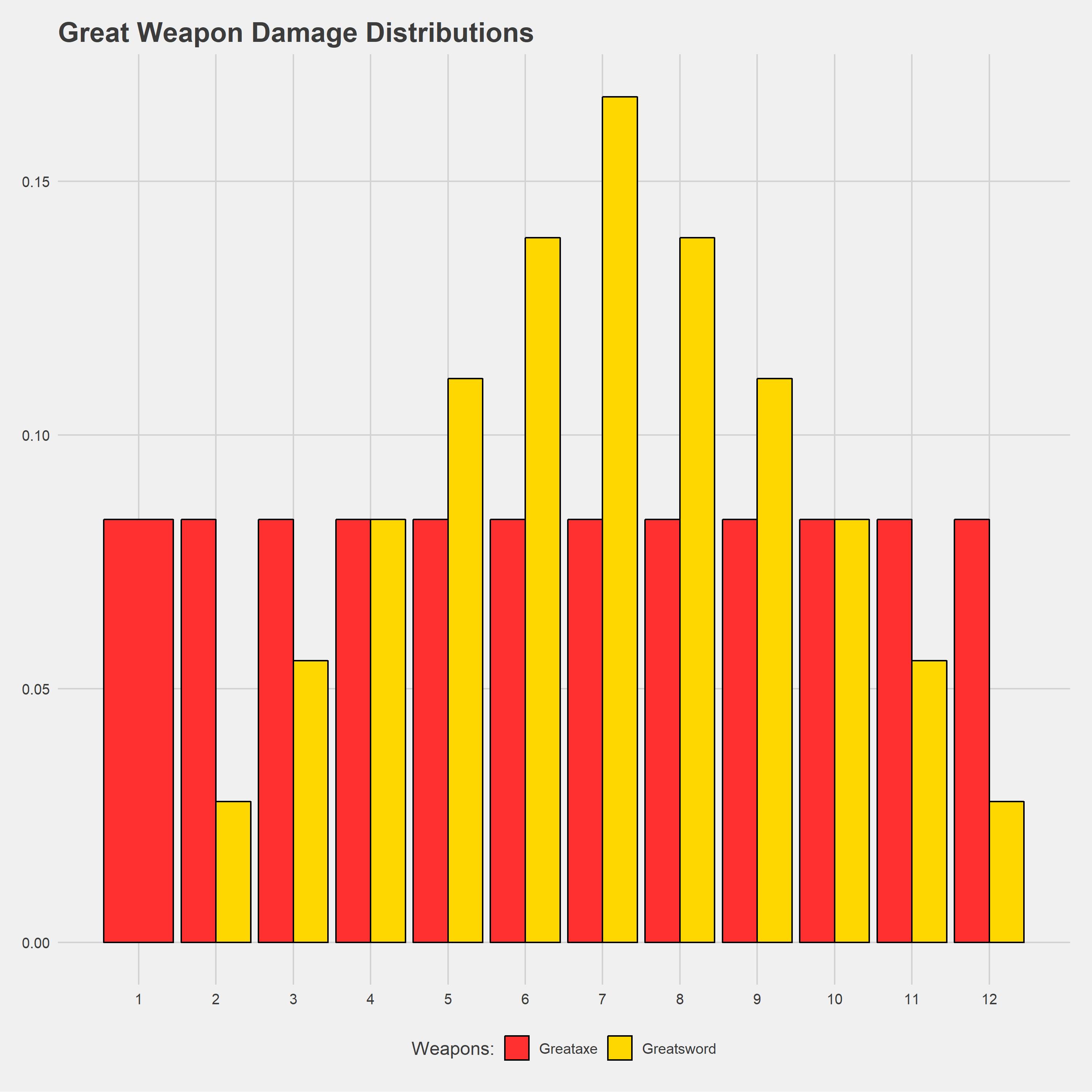 So let’s pick apart the obvious.
So let’s pick apart the obvious.
- You can roll a 1 with the Greatsword
- You have a higher chance of rolling mid-level damage with the Greatsword(5-9) What is less subtle until you’re looking at a visualization is:
- You have a harder chance of rolling a 2 or 3 with a Greatsword and no chance of rolling a 1.
- However you have a higher chance of rolling max damage with the Greataxe.
That being said, I think the real trade-off between the two Great weapons is that: With a GreatSword, you are going to be producing more damage consistently. If you look at your chances of rolling a 7 for example, you have about twice the likelihood of rolling that as opposed to a Greataxe. The Greataxe offers you a higher chance of hitting max damage. If you look at rolling 12 damage, you are three times more likely to achieve that with the Greataxe as opposed to the Greatsword.
I think that it is up to the players to decide which is more important to them(Consistency vs. high payoff), but I would say if you have character has features that let them reroll damage die, the Greataxe might be more viable.
 That being said, if our measurement of “best weapon” lies in consistency, I think the Longsword(1d8) is the clear winner.
It out performs the great weapons for majority of its spectrum, only losing in range and to the Greatsword at roll 6-8.
That being said, if our measurement of “best weapon” lies in consistency, I think the Longsword(1d8) is the clear winner.
It out performs the great weapons for majority of its spectrum, only losing in range and to the Greatsword at roll 6-8.
I think the big loser is actually using the Longsword(2h):
- You lose access to the second hand which gives you the options of holding a shield or spell casting
- You quickly lose out in damage consistency with the Greatsword
- You lose the range the Great weapons have.
Fighting Styles
Let’s explore one more facet of the game. These are fighting styles. In D&D characters can adopt a fighting styles which help them use their weapons in more unique ways. The two styles we are going to look at are called “Dueling” and “Great Weapon Fighting”.
The effects of the Dueling style states “When you are wielding a melee weapon in one hand and no other weapons(in your other hand), you gain a +2 bonus to damage rolls with that weapon. “
While Great Weapon Fighting states “When you roll a 1 or 2 on a damage die for an attack you make with a melee weapon that you are wielding with two hands, you can reroll the die and must use the new roll, even if the new roll is a 1 or a 2. The weapon must have the two-handed or versatile property for you to gain this benefit.”
The last fighting style I want to look at is called the Two-Weapon fighting style. This style states “When you engage in two-weapon fighting, you can add your ability modifier to the damage of the second attack.” For those of you who do not know of D&D game rules. Players can decided to hold certain weapons in both hands and make 2 attacks per turn. This is called duel-wielding. The second weapon must also have a classification tag as a “light” weapon. The second attack cannot benefit from a player’s personal damage modifier. What this fighting style does is allow a player to add their personal modifier to the damage rolls of both weapons, hopefully boosting your overall damage output.
Let’s start from the top and look at the Dueling Fighting Style
The Dueling Fighting Style
Remember dueling allows you to add +2 damage to a damage roll using a 1-handed weapon
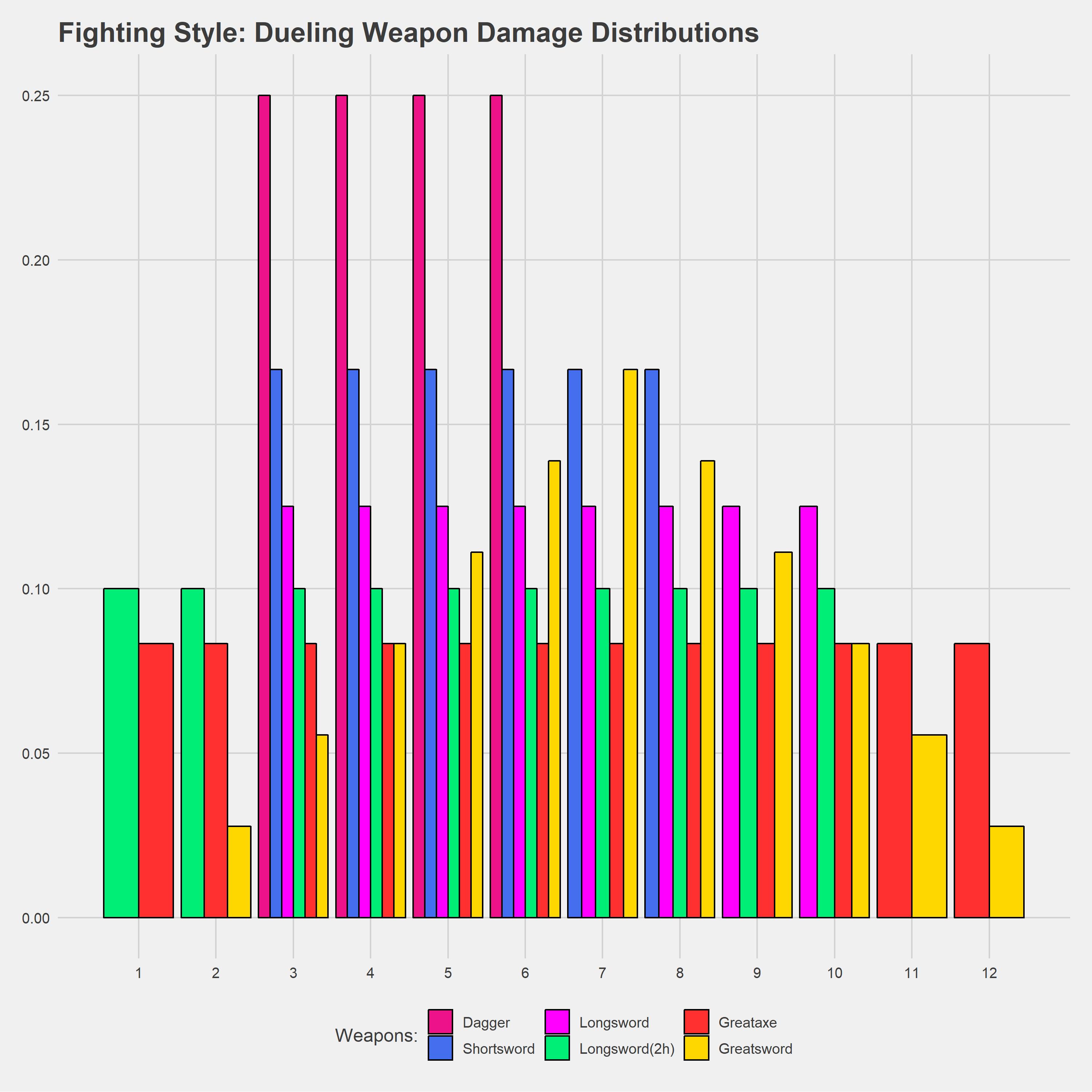
Here you can see that adding that +2 modifier to damage shifts the range of the weapons. Since it eliminates a 1-handed weapon’s chance of rolling a 1 or 2 it allows the damage probability to drastically compete with the two handed weapons. Here you can see that the Shortsword is able to outcompete the Greatsword up until the damage of 7.
While the Shortsword still beats the Longsword in consistent damage, I would like to point out that the Longsword is able to outcompete both Great weapons in the 9-10 damage range.
All in all, if your character has the ability to take a fighting style, and you are using a 1 handed weapon, take the Dueling fighting style. You gain a lot of the benefits of a two handed weapon, while maintaining your benefits of having a single free hand.
I always hate using the term “best” in D&D but I will say that Dueling is a highly desirable fighting style, if your characters go the melee focused route.
Great Weapon Fighting Style
Remember Great Weapon Fighting allows you to reroll 1-2 on your damage die, but you must use the new roll no matter what. This sets up a conditional probability
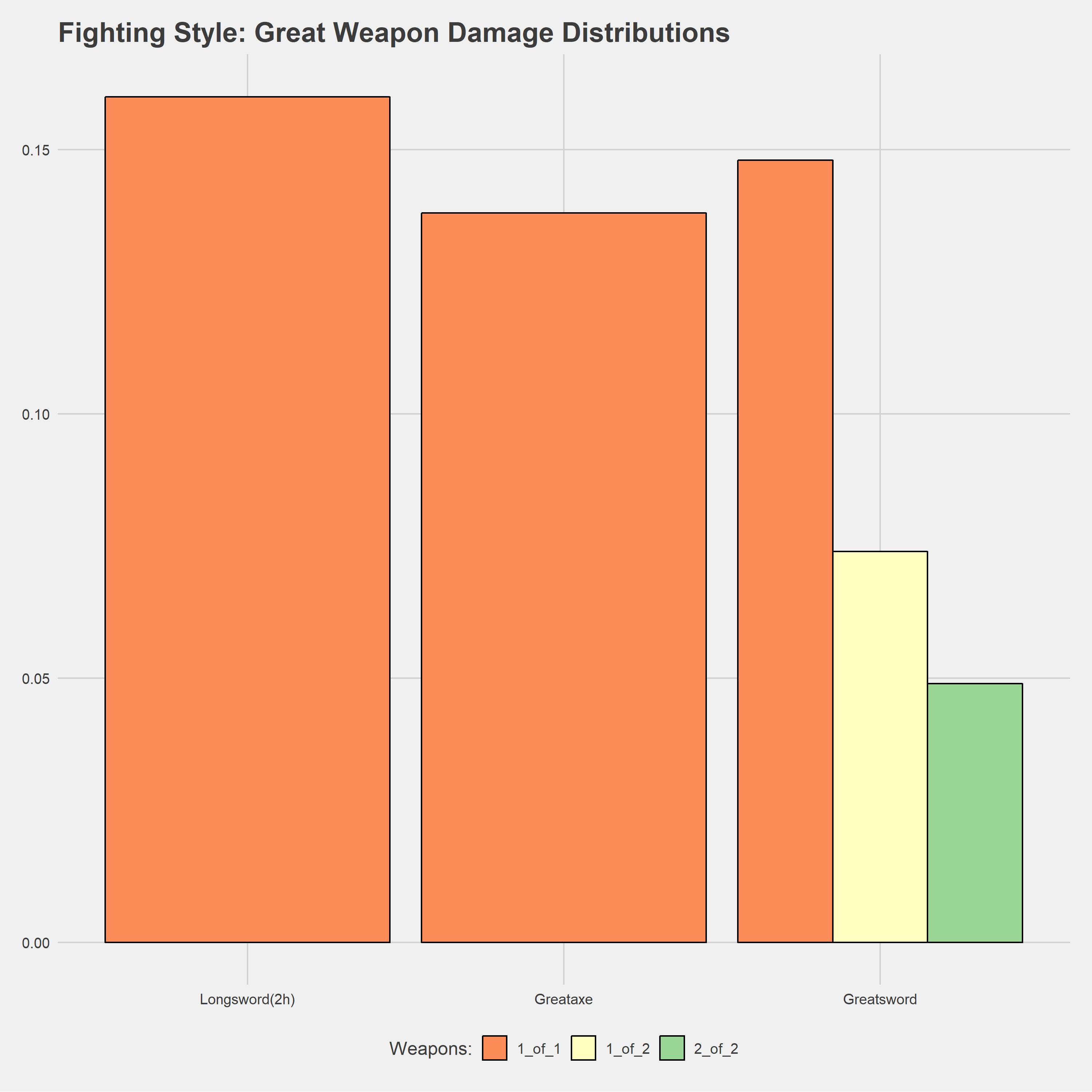
I want to clarify something, because this kind of confused me at first.
This is the r code
# Let's see how that translates with the Longsword(2h) weapon using a d10
getEventProb(nrolls = 2, # The number of rolls(Our original and our Reroll)
ndicePerRoll = 1, # Number of rolls
nsidesPerDie = 10, # Number of sides
eventList = list(1:2, 3:10), # The probability of events where: Our first roll is a 1 or 2, and our second is between 3 and 10
orderMatters = TRUE)
[1] 0.16
# Here you have about a 16% chance of increasing your damage.
# What this means is that AFTER you roll a 1 or 2 with a Longsword(2h) using this fighting style you have about a 16% of equally rolling any damage along your weapon's distribution higher than a 1 or 2
# So looking at our Greataxe we have this:
getEventProb(nrolls = 2, # The number of rolls(Our original and our Reroll)
ndicePerRoll = 1, # Number of rolls
nsidesPerDie = 12, # Number of sides
eventList = list(1:2, 3:12), # The probability of events where: Our first roll is a 1 or 2, and our second is between 3 and 12
orderMatters = TRUE)
# This is the probability of us using the Greatsword and rolling the 2d6
# This first event is us rolling a 1 or 2 on one die and then only rerolling 1 die, and that reroll being higher than a 1 or 2
getEventProb(nrolls = 3,
ndicePerRoll = 1,
nsidesPerDie = 6,
eventList = list(1:2,3:6, 3:6),
orderMatters = TRUE)
# This is the probability of us rolling the 2d6, and then having the rerolls both of our damage dice, and having both of those rolls being
# higher than a 1 or 2
getEventProb(nrolls = 4,
ndicePerRoll = 1,
nsidesPerDie = 6,
eventList = list(1:2,1:2,3:6, 3:6),
orderMatters = TRUE)
# And finally, the probability of use rolling the 2d6, needing to reroll both of those dice, and having only 1 higher than a 1 or 2
getEventProb(nrolls = 4,
ndicePerRoll = 1,
nsidesPerDie = 6,
eventList = list(1:2,1:2,1:6, 3:6),
orderMatters = TRUE)
What the output is saying and what is represented on the graph can be summed up in a sentence: After rolling a particular damage die and receiving a 1 or 2, if I reroll that die, the probability of me rolling and result higher than a 1 or 2 is _____
For once, it looks like the Longsword(2h) or the 1d10 actually comes out on top. Since it’s damage distribution is less spread out you have about a 16% chance of getting a higher roll on your reroll, if you roll a 1-2 on your initial roll.
Using a Greataxe, you have a 13.8% chance of rolling a higher number.
However, the Greatsword is where things get messy. Since you roll 2d6 I decided to look at 3 possibilities:
- The probability of having to reroll 1 dice, and that result being higher than a 1 or 2 (1 of 1)
- The probability of having to reroll 1 dice, and that result being higher than a 1 or 2 (1 of 2)
- The probability of having to reroll 2 dice, and both result being higher than a 1 or 2 (2 of 2)
It appears that Great Weapon Fighting style may not help a Greatsword user, nearly as much as it does the other weapons.
Two-Weapon Fighting Style
Finally, our last weapon style the Two-Weapon Fighting. Remember, normally when a character decided to duel wield, the attack they make with their second attack does not deliver bonus damage from their personal modifier. This style allows us to add a character’s personal modifier to the damage roll of the second attack which provides another source of damage.
The weapons we will be using in order to use this style must contain the “light” classification so from our set, I’ve decided to use the Dagger and the Shortsword.
Up until now, we have been talking about weapon damage distribution ignoring a character’s personal modifier. However those modifiers are mandatory for this style to be effective.
# For the Dagger
getSumProbs(ndicePerRoll = 2, # A second die for the bonus attack
nsidesPerDie = 4,
perDieModifier = 2) # Modifier added to each roll
# For the Shortsword
getSumProbs(ndicePerRoll = 2, # A second die for the bonus attack
nsidesPerDie = 6,
perDieModifier = 2) # Modifier added to each roll
That being said I decided to create two graphs.
The first graph shows how the Two-Weapon Fighting style effects damage distribution when you give the Dagger and Shortsword a +2 modifier compared to the normal set of weapons which have no modifier, which I labeled as unfair.
The next graph shows how the Two-Weapon Fighting style compares all weapons with the +2 modifier, which I labeled as fair
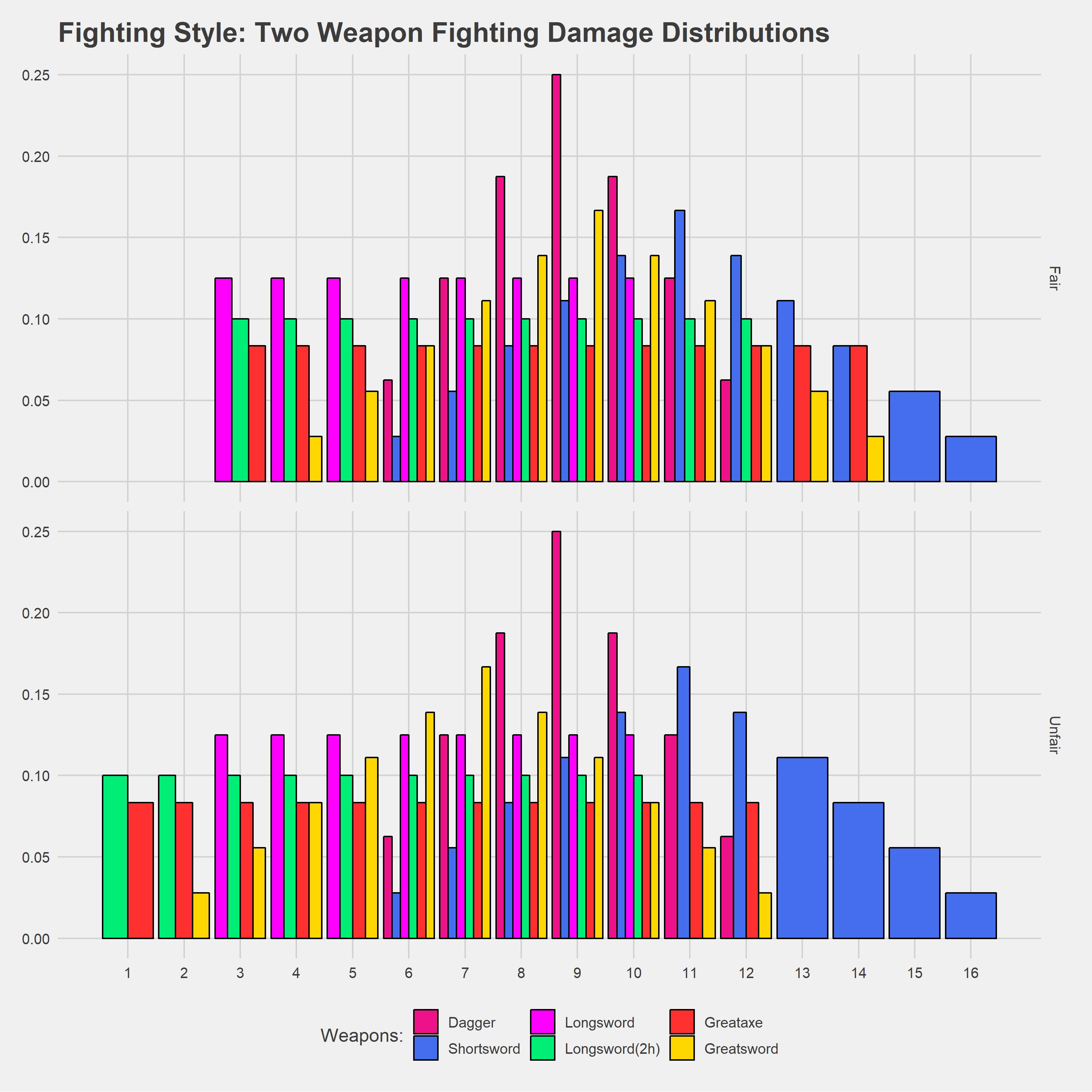
Here we can see that the little guys are finally on the rise! The dagger for example has a 25% chance of doing 9 damage total. Another impressive feat is the Shortsword, who out competes the great weapons in the higher tiers of damage. Looking at the “fair” portions sets readjust the effectiveness of the weapons, but a lot of promising qualities still remain.
Two-Weapon Fighting does have one major flaw. In order for any of these new distributions to matter, you must successful hit with both weapons!
And with all of that concluded, I think were done with this chapter! For those of you who like to skim to the bottom, I will summarized all of our findings here:
- With each additional side in a given die, you increase the range of damage you can perform while equally decreasing the probability of any 1 particular roll result.
- Adding additional dice to a roll, gives it a different distribution because it allows for particular roll probabilities to be no longer equal
- When comparing the great weapons, The Greatsword offers more consistency in mid damage output, while the Greataxe allows for higher tiers of damage to be obtained more frequently.
- Adding modifiers to a damage roll does not affect probability of a result but it does shift the range of damage.
- The Dueling Style places 1 handed weapons in a competitive damage range with great weapons, while not suffering their major drawbacks.
- While the Great Weapon Fighting Style can be helpful, the probability of increasing damage is small. It is the only time Longsword(2h) is the most viable option, so don’t use that weapon without this style.
- Two-Weapon Fighting makes the light weapons very competitive in dealing mid-high damage. It does however require you to hit with both attacks meaning that the style may be the most underutilized, given particular circumstances.
Thanks guys! I hope you enjoyed it, and I hope you learned something! Until next time!
